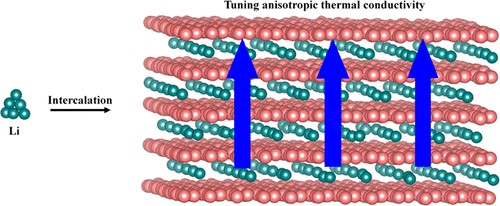当前位置:
X-MOL 学术
›
J. Phys. Chem. C
›
论文详情
Our official English website, www.x-mol.net, welcomes your
feedback! (Note: you will need to create a separate account there.)
Tunable Anisotropic Thermal Conductivity and Elastic Properties in Intercalated Graphite via Lithium Ions
The Journal of Physical Chemistry C ( IF 3.3 ) Pub Date : 2018-01-16 00:00:00 , DOI: 10.1021/acs.jpcc.7b09717 Zhiyong Wei 1 , Fan Yang 2 , Kedong Bi 1 , Juekuan Yang 1 , Yunfei Chen 1
The Journal of Physical Chemistry C ( IF 3.3 ) Pub Date : 2018-01-16 00:00:00 , DOI: 10.1021/acs.jpcc.7b09717 Zhiyong Wei 1 , Fan Yang 2 , Kedong Bi 1 , Juekuan Yang 1 , Yunfei Chen 1
Affiliation

|
The electrochemical intercalation of metal ions into layered materials is a useful strategy to reversibly tune thermal-transport properties, but the fundamental mechanisms are not well understood. In this study, we systematically investigated the effects of lithium-ion concentrations on the anisotropic thermal conductivity of intercalated graphite by molecular-dynamics simulations and a continuum-mechanics method. It was found that the in-plane thermal conductivity rapidly decreased to 34.3% of that of graphite in the same direction when the lithium-ion concentration increases to 0.1667. However, the cross-plane thermal conductivity first decreased to 23.7% of that of the graphite. Then, it surprisingly recovered to a thermal conductivity even higher than that of graphite when the lithium-ion concentration increased further. These two different trends and thermal-conductivity anisotropies were explained by extracting the phonon lifetimes and elastic constants of intercalated graphites with various lithium-ion concentrations. At lithium-ion concentrations lower than 0.05, the reduction of both the in-plane and cross-plane thermal conductivities in the intercalated graphite was attributed to the increased phonon scattering owing to the interactions between the lattices and ions. However, at lithium concentrations higher than 0.05, the thermal transport of the intercalated graphite was mainly influenced by anisotropic elastic constants. The rapidly increasing cross-plane elastic constants increased the cross-plane thermal conductivity, while simultaneously weakening the phonon-focusing effects along the in-plane direction, which resulted in the opposite tendencies of the in-plane and cross-plane thermal conductivities with increasing lithium-ion concentrations. This study provides important guidance in the active regulation of the anisotropic thermal conductivities of layered materials for thermal management in energy storage and conversion.
中文翻译:

锂离子对插层石墨的各向异性各向异性热导率和弹性特性的影响
金属离子电化学嵌入到层状材料中是一种可逆地调节热传输性能的有用策略,但是其基本机理尚未得到很好的理解。在这项研究中,我们通过分子动力学模拟和连续力学方法系统地研究了锂离子浓度对插层石墨各向异性导热系数的影响。发现当锂离子浓度增加到0.1667时,面内导热率在相同方向上迅速降低到石墨的34.3%。但是,横断面热导率首先下降到石墨的23.7%。然后,当锂离子浓度进一步增加时,其令人惊奇地恢复到甚至比石墨更高的导热率。通过提取不同锂离子浓度的插层石墨的声子寿命和弹性常数,可以解释这两种不同的趋势和导热系数各向异性。锂离子浓度低于0.05时,插层石墨的面内和面内热导率均降低,这归因于晶格和离子之间的相互作用,声子散射增加。然而,在锂浓度高于0.05时,插层石墨的热传递主要受各向异性弹性常数的影响。快速增加的横断面弹性常数增加了横断面热导率,同时削弱了沿平面内方向的声子聚焦效应,随着锂离子浓度的增加,这导致了面内和跨面热导率的相反趋势。这项研究为主动调节层状材料的各向异性热导率提供了重要的指导,以进行能量存储和转换中的热管理。
更新日期:2018-01-16
中文翻译:

锂离子对插层石墨的各向异性各向异性热导率和弹性特性的影响
金属离子电化学嵌入到层状材料中是一种可逆地调节热传输性能的有用策略,但是其基本机理尚未得到很好的理解。在这项研究中,我们通过分子动力学模拟和连续力学方法系统地研究了锂离子浓度对插层石墨各向异性导热系数的影响。发现当锂离子浓度增加到0.1667时,面内导热率在相同方向上迅速降低到石墨的34.3%。但是,横断面热导率首先下降到石墨的23.7%。然后,当锂离子浓度进一步增加时,其令人惊奇地恢复到甚至比石墨更高的导热率。通过提取不同锂离子浓度的插层石墨的声子寿命和弹性常数,可以解释这两种不同的趋势和导热系数各向异性。锂离子浓度低于0.05时,插层石墨的面内和面内热导率均降低,这归因于晶格和离子之间的相互作用,声子散射增加。然而,在锂浓度高于0.05时,插层石墨的热传递主要受各向异性弹性常数的影响。快速增加的横断面弹性常数增加了横断面热导率,同时削弱了沿平面内方向的声子聚焦效应,随着锂离子浓度的增加,这导致了面内和跨面热导率的相反趋势。这项研究为主动调节层状材料的各向异性热导率提供了重要的指导,以进行能量存储和转换中的热管理。











































 京公网安备 11010802027423号
京公网安备 11010802027423号